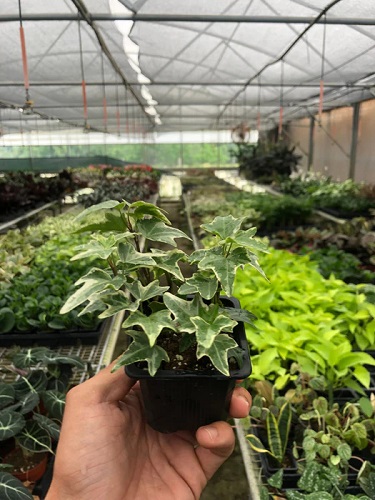English Ivy, also known as Hedera, is a popular greenhouse plant that is easy to care for and provides lush green foliage. Here are some tips for growing Ivy in a greenhouse.
Basic Care
Light

Ivy plants prefer bright, indirect light. Place them near a window or use artificial lighting to supplement.
Water
Hedera plants like to have evenly moist soil, but not waterlogged. Water the soil directly, avoiding getting water on the leaves to prevent leaf rot.
Soil
Use a well-draining potting mix that is rich in organic matter.
Fertilizer
Temperature
Feed Ivy plants with a balanced water-soluble fertilizer every 2-4 weeks during the growing season.
Ivy plants prefer temperatures between 60°F to 75°F (15°C to 24°C).
Humidity
Ivy plants prefer high humidity levels, which can be achieved by placing a tray of water near the plant or using a humidifier.
Pruning
Prune Hedera plants regularly to control growth and maintain their shape.
Propagation
English Ivy is a fast-growing, evergreen climbing plant that is easy to propagate. Here are two methods for propagating hedera:
Cuttings
The easiest and most common method for propagating hedera is through stem cuttings. Cut a stem that is about 4-6 inches long, making the cut just below a node (the point on the stem from which leaves emerge). Remove the leaves from the bottom half of the cutting and dip the cut end into rooting hormone powder. Plant the cutting in a pot filled with a moist rooting medium, such as perlite and peat moss, and cover the pot with plastic wrap to create a humid environment. Place the pot in bright, indirect light and keep the rooting medium moist. In a few weeks, roots should have formed and new growth should appear.
Layering
This method is best done in the spring or early summer. Find a stem that is growing near the soil and gently bend it to the soil, pinning it in place with a U-shaped wire. Cover the bent stem with soil or a rooting medium and water well. The stem should root within a few months, and you can then cut it away from the parent plant and pot it up.
Regardless of which method you choose, be sure to keep your newly propagated hedera out of direct sunlight and keep the soil consistently moist, but not waterlogged, until they are established.
10 Fun Facts About English Ivy
Hedera, commonly known as Ivy, is a genus of evergreen climbing or trailing plants in the family Araliaceae.
Ivy is native to the Eastern Mediterranean and Western Asia but has been introduced and naturalized in many other parts of the world.
Ivy is a versatile plant that can grow as a ground cover, a climber, or as a trailing plant, making it a popular choice for gardeners and landscapers.
Ivy is a hardy plant and can tolerate a wide range of growing conditions, including shady locations and dry soils.
Ivy is a popular choice for green walls, living walls and greenhouses, as it can thrive in these vertical environments.
Ivy is an important food source for many species of birds and insects, and it is also used as a nesting site for birds.
Ivy has been used for thousands of years for medicinal purposes, with the ancient Greeks and Romans using it to treat a range of ailments, including skin irritations and respiratory problems.
Ivy is often associated with the holiday season and is commonly used as a decoration, particularly in Europe.
There are many different species of ivy, each with its own unique characteristics, including the evergreen ivy, which remains green year-round, and the variegated ivy, which has leaves with multiple colors.
Ivy is also a popular choice for bonsai, as its small leaves and flexible stems make it easy to shape and maintain.
Related Articles & Free Email Newsletter Sign Up
5 Indoor Plants that Require No Time or Energy
Coleus is a Versatile Plant that Comes in Over 600 Varieties




Comment here